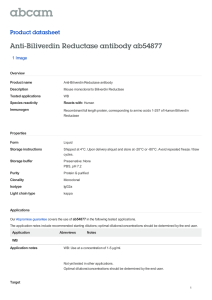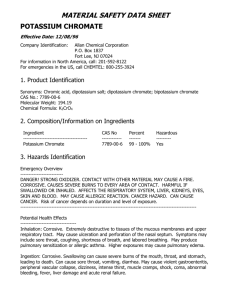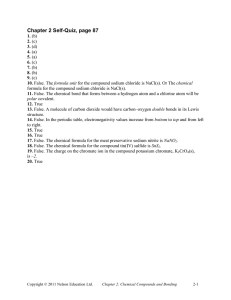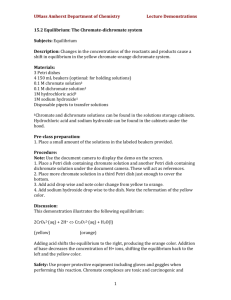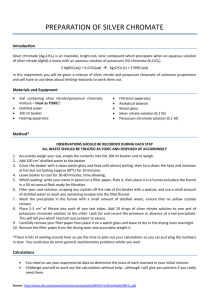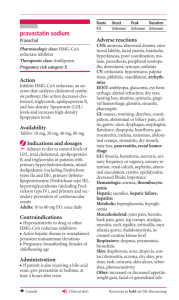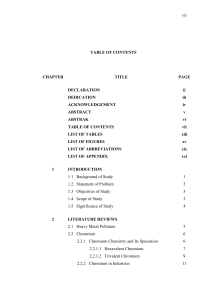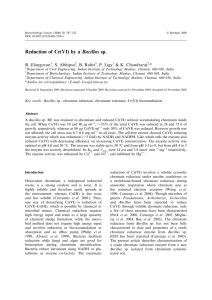1 The contamination of our water ... Cr(VI) is of concern. Cr(VI) originates from various anthropogenic...
advertisement
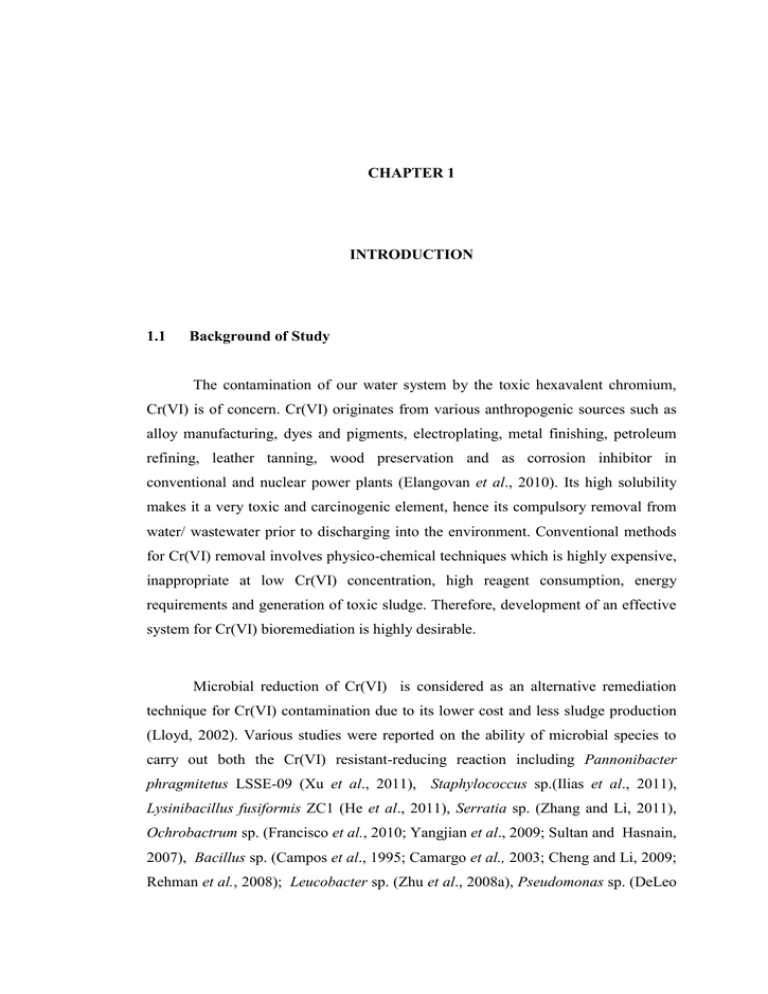
1 CHAPTER 1 INTRODUCTION 1.1 Background of Study The contamination of our water system by the toxic hexavalent chromium, Cr(VI) is of concern. Cr(VI) originates from various anthropogenic sources such as alloy manufacturing, dyes and pigments, electroplating, metal finishing, petroleum refining, leather tanning, wood preservation and as corrosion inhibitor in conventional and nuclear power plants (Elangovan et al., 2010). Its high solubility makes it a very toxic and carcinogenic element, hence its compulsory removal from water/ wastewater prior to discharging into the environment. Conventional methods for Cr(VI) removal involves physico-chemical techniques which is highly expensive, inappropriate at low Cr(VI) concentration, high reagent consumption, energy requirements and generation of toxic sludge. Therefore, development of an effective system for Cr(VI) bioremediation is highly desirable. Microbial reduction of Cr(VI) is considered as an alternative remediation technique for Cr(VI) contamination due to its lower cost and less sludge production (Lloyd, 2002). Various studies were reported on the ability of microbial species to carry out both the Cr(VI) resistant-reducing reaction including Pannonibacter phragmitetus LSSE-09 (Xu et al., 2011), Staphylococcus sp.(Ilias et al., 2011), Lysinibacillus fusiformis ZC1 (He et al., 2011), Serratia sp. (Zhang and Li, 2011), Ochrobactrum sp. (Francisco et al., 2010; Yangjian et al., 2009; Sultan and Hasnain, 2007), Bacillus sp. (Campos et al., 1995; Camargo et al., 2003; Cheng and Li, 2009; Rehman et al., 2008); Leucobacter sp. (Zhu et al., 2008a), Pseudomonas sp. (DeLeo 2 and Ehrlich, 1994; Badar et al., 2000; McLean et al., 2000), Exiguobacterium sp. (Okeke, 2008), Acinetobacter haemolyticus (Zakaria et al., 2007a; 2007b) and others. Most of the biological systems for the treatment of Cr(VI)-containing wastewater using microbial Cr(VI) reduction are operated in batch mode (Elangovan et al., 2010). However, this system is not fully effective (compared to continuous or fixed film bioreactor system) with an eventual loss of active biomass. This was mainly due to metal toxicity and stage of biofilm development which has not fully matured. Several improvements are needed both at the enzymatic as well as cellular levels for bacteria to work efficiently as agents for chromate bioremediation (Arkerley et al., 2004b) Chromate reductase activity can be found in the cell extracts of many bacteria either in crude, partial or purified fractions. Chromate reductase facilitates the reduction of Cr(VI) to Cr(III) either in aerobic or anaerobic conditions. Aerobic Cr(VI) reduction is generally associated with a soluble fraction that utilizes NADH as an electron donor (Kwak et al., 2003). Conversely, anaerobic Cr(VI) reduction is mediated by membrane bound cytochrome b, c and d, (Bopp and Ehlirch, 1988 and Lovley and Phillips, 1994) or cytoplasmic membrane proteins (Myers et al., 2000). Though many reports are available on the use of whole cell reactors for the treatment of Cr(VI)-contaminated wastewater, uses of purified, partially purified or crude enzymes in bioremediation of Cr(VI) from contaminated wastewater treatment is almost unheard of. This makes it imperative to find and employ an effective way to remediate Cr(VI) by using highly active enzyme (chromate reductase) isolated from Cr(VI) resistant-reducing microorganism. 1.2 Statement of Problem This study is a result from the Cr(VI) reduction system i.e. ChromeBac™ which has been developed at the laboratory and pilot-scale in Universiti Teknologi Malaysia, Skudai for the past 7 years. ChromeBac™ is a novel and environmental– friendly system to treat Cr(VI)–bearing water consisting of bioreactor packed with sawdust-immobilized Cr(VI) resistant-reducing bacteria. One novel-locally isolated 3 bacterium, Acinetobater haemolyticus (A. haemolyticus, GenBank Acession No. EF369508) acts as the primary bacterium in the ensuing biofilm formed during the non-sterile Cr(VI) reduction process using real Cr(VI)-containing industrial wastewaters. Amongst the important observations made during the ChromeBac™ process is the substantial retention time needed to complete Cr(VI) reduction. This was due to the immaturity of the biofilm system (Zakaria et al., 2007a; 2007b; Ahmad et al., 2009b) and the need for intermittent reseeding of the bioreactor. Hence, the use of enzymes (chromate reductase) isolated from bacteria itself may be a suitable option for the effective Cr(VI) reduction as compared to whole cells. Previously, it was demonstrated that the Cr(VI) reduction–resistance pathways for the bacterium occured aerobically in the soluble proteins fractions (Pei et al., 2009). Therefore, in the present study, enzymatic reduction of Cr(VI) and optimum conditions for chromate reductase isolated from Acinetobater haemolyticus will be evaluated. 1.3 Objectives of Study The objective of this study was to compare the chromate reductase activity in the whole cells and crude cell-free extract of Acinetobacter haemolyticus. This shall be assessed by elucidating the sub-cellular localization of chromate reductase, to assess in vitro characterization of the enzymatic chromate reductase activity in cell free-extract (cytosolic fractions) and to investigate the performance of immobilizedchromate reductase to reduce Cr(VI) by Acinetobacter haemolyticus. 1.4 Scope of Study Cr(VI) resistance and reduction study of A. haemolyticus was assessed in LB medium supplemented with various Cr(VI) concentrations. To elucidate the role of enzymes and abiotic reduction during Cr(VI) reduction, Cr(VI) reduction assay was 4 carried out aerobically under growth and non-growth conditions. Instrumental analysis was carried out to investigate the metal-microbe interaction during Cr(VI) reduction such as FTIR, FESEM-EDX, TEM and ESR. The chromate reductase activity was determined via in-vitro enzymatic study using sub-cellular fractions where fractions with high chromate reductase activity were assessed for protein contents, effect of temperature, pH, metal ions, metabolic inhibitors, electron donors and kinetic study (Km, Vmax, Ki). The enzyme fraction was immobilized in calcium alginate and evaluated for its Cr(VI) reduction ability in batch system using parameters such as initial pH of Cr(VI), temperature, agitation speed, bead dosage and effect of contact time and initial Cr(VI) concentration. The reusability of beads immobilized-chromate reductase also was investigated. 1.5 Significance of Study The significance of this study is to evaluate the feasibility of using enzymatic extracts from the previously isolated Cr(VI) resistant-reducing A. haemolyticus, in an attempt to improve the Cr(VI) reduction levels of the previously developed biofilm system.
